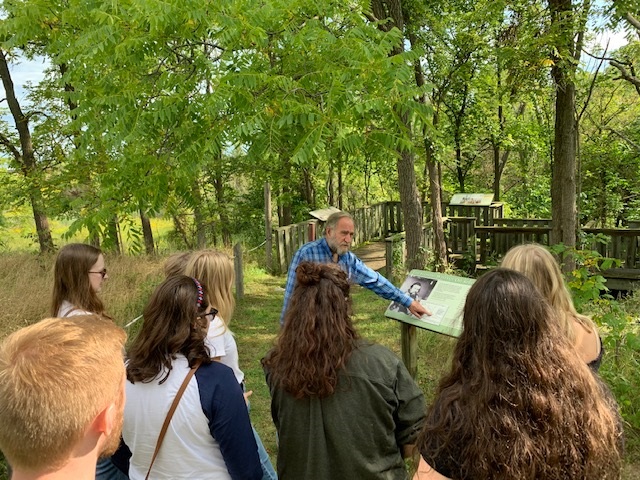The first oil available to North Americans came from right here in Oil Springs. That was 161 years ago and we are still learning more about the continent’s first oil boom. The Oil Springs’ spectacular boom only lasted from 1858 to 1866, but it triggered great strides in technology and led to Petrolia becoming Canada’s first oil capital.
Research is the key to learning more. In September, Western University’s history students working on their graduate degrees, made their annual tour of the Oil Museum of Canada and Fairbank Oil Fields. The students are introduced to the rich array of opportunities that are ripe for Oil Springs research projects for them to pursue if they apply for the Robert Cochrane Fellowship. This six-week fellowship has been operating since 2002 and has produced some excellent projects and boosted careers.

Charlie Fairbank, owner of Fairbank Oil Fields, shows Western University students the interpretive sign describing the amazing 32 flowing wells of Oil Springs surveyed by Sandford Fleming in 1862. These flowing wells produced hundreds, even thousands of barrels of oil daily for a short time.
-Photo courtesy of Assistant Prof. Michael Dove
In the most celebrated Robert Cochrane Fellowship project, Dana Thorne overturned accepted wisdom that it was Hugh Nixon Shaw who struck Canada’s first gusher here in 1862. She discovered it was actually struck by John Shaw, a universally disliked oilman who was working wells in Petrolia. His Petrolia co-workers so disliked him there that they ridded themselves of him by giving him an acre in Oil Springs. This rerouted history! His Oil Springs’ gusher diverted all attention from the early work in Petrolia and fuelled the famous oil rush of Oil Springs.
In contrast, Hugh Nixon Shaw, was a highly respected founder of Oil Springs and liked by all. Everyone was saddened when he died of asphyxiation deep in his Oil Springs well. Diving into documents, Thorne discovered the history of the two Shaw men, in the same place at the same time, got muddled somewhere in the 1950s and Hugh Nixon Shaw, incorrectly, was given credit for the first gusher.
Dana Thorne went on to head up the Lambton County Archives and is now the curator/supervisor of the Lambton Heritage Museum in Grand Bend.
More recently, fellowship students worked on creating a virtual exhibit of the artifacts collected by Lambton County’s famous International Drillers. Hundreds of these highly skilled drillers helped open oil fields in 86 countries between 1873 and 1945. The virtual exhibit is nearing completion.
Fairbank Oil Fields has also had excellent technology research produced by the West Virginia University. Additionally, PhD students from the University of Toronto found that plants at Fairbank Oil Fields contain bacteria which eats oil.
– Patricia McGee
